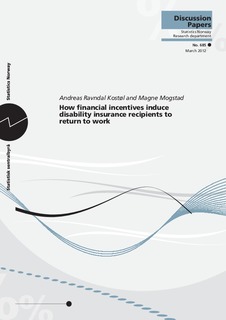| dc.contributor.author | Kostøl, Andreas Ravndal | |
| dc.contributor.author | Mogstad, Magne | |
| dc.date.accessioned | 2012-08-18T17:44:36Z | |
| dc.date.available | 2012-08-18T17:44:36Z | |
| dc.date.issued | 2012 | |
| dc.identifier.issn | 1892-753x | |
| dc.identifier.uri | http://hdl.handle.net/11250/180055 | |
| dc.description.abstract | Disability Insurance (DI) programs have long been criticized by economists for apparent work disincentives. Some countries have recently modified their programs such that DI recipients are allowed to keep some of their benefits if they return to work, and other countries are considering similar return-to-work policies. However, there is little empirical evidence of the effectiveness of programs that incentivize the return to work by DI recipients. Using a local randomized experiment that arises from a sharp discontinuity in DI policy in Norway, we provide transparent and credible identification of how financial incentives induce DI recipients to return to work. We find that many DI recipients have considerable capacity to work that can be effectively induced by providing financial work incentives. We also show that providing work incentives to DI recipients may both increase their disposable income and reduce program costs. Our findings also suggest that tar-geted policies may be the most effective in encouraging DI recipients to return to work.
Keywords: Disability insurance, financial incentives, labor supply, regression discontinuity design
_______________ Flere vestlige land har i de siste årene endret systemet for uføre slik at uføretrygdede kan beholde
deler av uførepensjonen hvis arbeidsevnen bedres og de gjenopptar inntektsgivende arbeid. Vi studerer
en norsk reform som fjernet den kraftige avkortningen i uførepensjon når arbeidsinntekten til
uføretrygdede overstiger grunnbeløpet. Vi finner at mange trygdede er villig til å jobbe hvis de
økonomiske insentivene forsterkes. Videre finner vi at i tillegg til å øke den disponible inntekten til
uføretrygdede som begynner å jobbe, kan Folketrygdens kostnader reduseres ved å styrke insentivene
for arbeidsdeltakelse. Våre resultater tyder også på at tiltak rettet mot yngre uføretrygdede kan være
den mest effektive måten for å fremme økt arbeidsdeltakelse. | no_NO |
| dc.description.sponsorship | Financial support from the Ministry of Finance, the Ministry of Labor and
the Norwegian Research Council. | no_NO |
| dc.language.iso | eng | no_NO |
| dc.publisher | Statistics Norway, Research department | no_NO |
| dc.relation.ispartofseries | Discussion papers (Statistisk sentralbyrå. Forskningsavdelingen);No. 685 | |
| dc.subject | Disability insurance | no_NO |
| dc.subject | Financial incentives | no_NO |
| dc.subject | Labor supply | no_NO |
| dc.subject | Return to work | no_NO |
| dc.subject | JEL classification: H53 | no_NO |
| dc.subject | JEL classification: H55 | no_NO |
| dc.subject | JEL classification: I18 | no_NO |
| dc.subject | JEL classification: J21 | no_NO |
| dc.subject | Uførepensjon | no_NO |
| dc.subject | Folketrygden | no_NO |
| dc.subject | Norge | no_NO |
| dc.subject | Sysselsetting | no_NO |
| dc.title | How financial incentives induce disability insurance recipients to return to work | no_NO |
| dc.type | Working paper | no_NO |
| dc.subject.nsi | VDP::Social science: 200::Economics: 210::Economics: 212 | no_NO |
| dc.source.pagenumber | 48 s. | no_NO |
